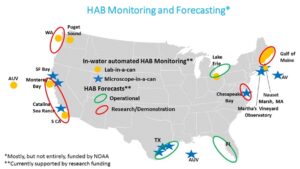The National Harmful Algal Bloom Observing Network (NHABON) Working Group recently met to document current HAB observing capabilities and identify outstanding requirements or gaps in existing regional observing networks. During the workshop, the working group assessed each network according to user community served, socioeconomic benefits, partnerships, integration, and costs to develop, sustain, and improve them. The two-day workshop was hosted by NOAA’s Integrated Ocean Observing System (IOOS) and National Centers for Coastal Ocean Science (NCCOS) with a goal to discuss the design and development of a framework for a NHABON, with representatives from five NOAA Line Offices (NESDIS, NMFS, NWS, NOS, and OAR). The NHABON effort is presently focused on six priority regions (Pacific Northwest, Florida, Lake Erie, California, Gulf of Maine, Texas), based on HABHRCA re-authorization context and the current status of HAB observing and forecasting infrastructure. The working group will begin coordinating with external partners and stakeholders and NOAA leadership to implement a process to describe, at regional and national levels, diverse user needs and to complete the design for a National HAB Observing capability.

Observations and measurements of HAB species and toxins are critical to support early warning, forecasting (e.g., initializing models, validating model outputs), and research on HAB growth and toxin dynamics. Many regional observing assets currently in use are funded through short-term research projects, which will lead, in the near future, to the loss of critical observing and data acquisition infrastructure used by forecasters and decision makers. NOAA has recently reaffirmed its commitment to the Ecological Forecasting Roadmap and the transition to operations of additional HAB forecasts is at the forefront of this effort. A coordinated, sustained National HAB Observing capability is needed to efficiently and effectively integrate local, state, regional, and Federal HAB observing capabilities and deliver early warning and forecast products operationally.
